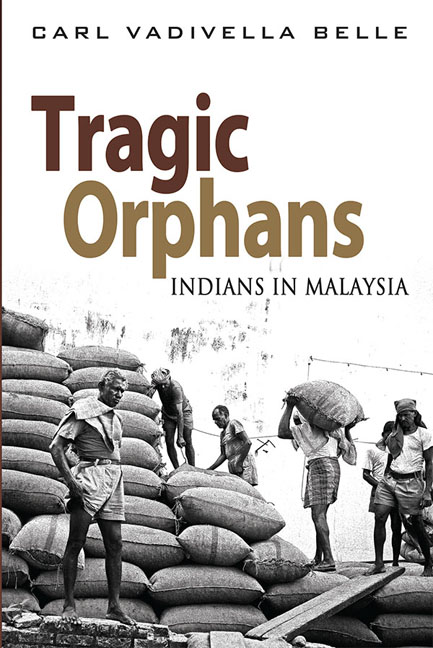Book contents
- Frontmatter
- Contents
- Acknowledgements
- List of Abbreviations
- Introduction
- 1 The Malay Peninsula: Early History, Melaka and the Colonial Setting
- 2 European Colonialism and the Malay Peninsula
- 3 India and the Development of British Ideologies of Empire
- 4 British Governance of Malaya
- 5 Slavery and Indentured Labour
- 6 Indian Indentured Labour in Malaya
- 7 Kangany Labour in Malaya
- 8 Other Indian Immigration
- 9 Indian Political Development to 1941
- 10 The Japanese Invasion, Subhas Chandra Bose and Indian Wartime Nationalism
- 11 The Post–war Period: Reform and Repression: 1945–48
- 12 From Federation to Merdeka
- 13 From Malaya to Malaysia: Singapore, 13 May and the New Economic Policy
- 14 The Mahathir Years: A Changing Malaysian Landscape
- 15 Abdullah Badawi, Islamization, and the Rise of Hindraf
- 16 Najib and 1Malaysia: A New Deal?
- Conclusions
- Bibliography
- Index
9 - Indian Political Development to 1941
Published online by Cambridge University Press: 06 June 2017
- Frontmatter
- Contents
- Acknowledgements
- List of Abbreviations
- Introduction
- 1 The Malay Peninsula: Early History, Melaka and the Colonial Setting
- 2 European Colonialism and the Malay Peninsula
- 3 India and the Development of British Ideologies of Empire
- 4 British Governance of Malaya
- 5 Slavery and Indentured Labour
- 6 Indian Indentured Labour in Malaya
- 7 Kangany Labour in Malaya
- 8 Other Indian Immigration
- 9 Indian Political Development to 1941
- 10 The Japanese Invasion, Subhas Chandra Bose and Indian Wartime Nationalism
- 11 The Post–war Period: Reform and Repression: 1945–48
- 12 From Federation to Merdeka
- 13 From Malaya to Malaysia: Singapore, 13 May and the New Economic Policy
- 14 The Mahathir Years: A Changing Malaysian Landscape
- 15 Abdullah Badawi, Islamization, and the Rise of Hindraf
- 16 Najib and 1Malaysia: A New Deal?
- Conclusions
- Bibliography
- Index
Summary
Until the period immediately preceding the Japanese invasion of December 1941, the Indian population of Malaya showed no real awareness of a common identity; the cleavages of class, caste and ethnicity militated against the development of any expressive communal solidarity. The greatest of these divisions was class. By 1939 there were approximately 700,000 Indians resident in Malaya comprising fifteen per cent of the total population. Of these, only four per cent were occupied in trade, business, or the professions, while approximately ten per cent were employed in skilled and semi-skilled occupations. The remainder were absorbed in unskilled or menial work.
The large working class existed in a continuous state of abject poverty. As we have seen, plantation employers viewed the Indian labourer as a simple being, who had been conditioned by his experiences in India to a desperately low standard of living. By emigrating to Malaya, he had supposedly been rescued from a life of semi-starvation and chronic indigence, and introduced to an environment where his minimal wants and basic needs were more than adequately met by the low wages the industry was prepared to pay.
The contempt felt by European administrators and planters for Indian labourers was echoed by the Indian professional and middle classes. In general, members of these classes spared no attempt to distance themselves from the Indian workforce, and to demonstrate to other Malayan communities their inherent difference from the “illiterate” Indian labouring classes. In asserting their putative superiority, middle-class Indians were just as prepared as Europeans to categorize all Indian labourers with the pejorative label “coolie”; lowly beings unworthy of consideration. These strata of Indian society could not be expected to understand, let alone empathize with the problems faced by Indian labour.
As we have seen in the previous chapters, on plantations and in urban workplaces, workers were directly managed by administrative and field staff consisting mainly of Malayalees and Jaffna Tamils. “Coolie” labour and administrators were thus unable to forge bonds based on common identity, and indeed relations were often riven by mutual distrust and suspicion.
The debasement of “coolie” labour, by both the European community and their own middle class and professional compatriots, effectively isolated the Indian labouring classes and emphasized their social and political impotence.
- Type
- Chapter
- Information
- Tragic OrphansIndians in Malaysia, pp. 149 - 175Publisher: ISEAS–Yusof Ishak InstitutePrint publication year: 2014

